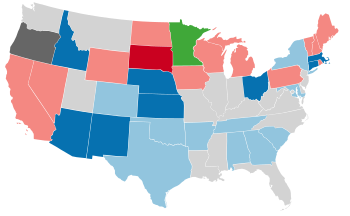| ← 1928 1929 1930 1931 1932 → Midterm elections | |
| Election day | November 4 |
|---|---|
| Incumbent president | Herbert Hoover (Republican) |
| Next Congress | 72nd |
| Senate elections | |
| Overall control | Republican hold |
| Seats contested | 35 of 96 seats (32 Class 2 seats + 7 special elections) |
| Net seat change | Democratic +8 |
 | |
| 1930 Senate election results
Democratic gain Democratic hold | |
| House elections | |
| Overall control | Democratic gain |
| Seats contested | All 435 voting seats |
| Popular vote margin | Republican +8.5% |
| Net seat change | Democratic +52 |
 | |
| Gubernatorial elections | |
| Seats contested | 33 |
| Net seat change | Democratic +7 |
 | |
| 1930 gubernatorial election results
Democratic gain Democratic hold | |
The 1930 United States elections were held on November 4, 1930, in the middle of Republican President Herbert Hoover's term. Taking place shortly after the start of the Great Depression, the Republican Party suffered substantial losses. The election was the last of the Fourth Party System, and marked the first time since 1918 that Democrats controlled either chamber of Congress.
The Republicans lost fifty-two seats to the Democratic Party in the House of Representatives. While the Republicans maintained a one-seat majority after the polls closed, they lost a number of special elections (since some Republican members died) before the start of the new Congress. This allowed the Democrats to take control of the chamber.
The Republicans also lost eight seats to the Democrats in the U.S. Senate, but were able to narrowly maintain control.
The election was a victory for progressives of both parties, as Republicans closely aligned with Hoover lost several Congressional elections. Additionally, New York Governor Franklin D. Roosevelt's landslide re-election established him as the front-runner for the 1932 Democratic nomination.
See also
- 1930 United States House of Representatives elections
- 1930 United States Senate elections
- 1930 United States gubernatorial elections
References
- Four Class 2 seats held both a regularly-scheduled election and a special election in 1930. These seats are not double-counted for the total number of seats contested.
- Democrats picked up six seats in the regularly-scheduled elections and an additional two seats in the special elections.
- Democrats fell just short of winning a majority in the regularly-scheduled elections of 1930, but they won a majority in special elections that preceded the next Congress.
- ^ "Party Divisions of the House of Representatives". United States House of Representatives. Retrieved June 25, 2014.
- "Party Division in the Senate, 1789-Present". United States Senate. Retrieved June 25, 2014.
- "Statistics of the Congressional Election of November 4, 1930" (PDF). U.S. House of Reps, Office of the Clerk. Retrieved December 29, 2011.
- Busch, Andrew (1999). Horses in Midstream. University of Pittsburgh Press. pp. 77–78.
This American elections-related article is a stub. You can help Misplaced Pages by expanding it. |